The point of care is moving from in-person appointments to digital channels like telemedicine visits, remote monitoring and virtual consultations at a fast clip. The shift has been accelerated by increased regulatory support, technological advancements, and of course, the need to reduce patient exposure to the new coronavirus. As CMS Administrator Seema Verma told The Wall Street Journal, “I think it’s fair to say that the advent of telehealth has been just completely accelerated, that it’s taken this crisis to push us to a new frontier, but there’s absolutely no going back.” With telehealth so ingrained in the delivery of care, pharma needs to rethink and adapt its standard sales and marketing approach to fit into this new world.
Telehealth is more than a channel for delivering care, it reflects a fundamental shift in how brands reach patients and physicians. Until now, the in-person delivery of care has anchored brand marketing in the geographic perspective. Sales territories, advertising DMAs and managed care tactics have all been focused on specific U.S. regions. Geography has less significance in telehealth, so tactics that are free of the geographic distinction, such as digital marketing, are more critical.
Physicians are providing telehealth services to patients in two ways, each with different implications for pharma. First, there are vertically integrated virtual practices like PlushCare or 98point6. Then there are brick-and-mortar offices, where physicians provide telehealth visits either by signing up with a company like Teladoc Health or Amwell to deliver telehealth during their off-hours or by offering telehealth visits to existing patients in place of in-person visits using Zoom, FaceTime and other teleconference platforms. Practices using Zoom and other teleconference platforms are rapidly implementing telehealth programs that integrate into their workflows and EMR systems.
“Telehealth is more than a channel for delivering care, it reflects a fundamental shift in how brands reach patients and physicians.”
With all the changes to care delivery, pharma companies must align their commercial strategies to telehealth’s impact. Here are six ways to get started:
1. Factor telehealth into annual plans. There are a few ways that sales forces can ensure that the telehealth trend is factored into annual planning. First, telemedicine needs to be included in the territory mapping and sales force alignment calculations. Claims analysis can be used to understand which physicians are engaging in telehealth and what percentage of their practices’ care is delivered via telehealth vs. in-person. This can help reps understand how to approach these physicians in their detailing efforts, specifically whether they need to create a hybrid rep outreach, or a mix of in-person and virtual details.
For large telehealth platforms and virtual practices like PlushCare, an account management strategy may be more appropriate. In this approach, key account management teams would work directly with headquarters to design and deliver impactful educational detail experiences to their physician customers and integrate drug information into their platform workflow.
Second, incentive compensation strategies also need align to the telehealth activities. Physicians and patients could be in different regions, requiring a digital data strategy to gather prescription information and align with the IC plan.
Last, nonpersonal professional communication and customer-centric marketing (CCM) strategies also need to be adapted to match the way that physicians are engaging with patients. Messages and materials, along with “next-best action” AI algorithms can include telehealth activity as a trigger to provide digital educational and patient materials.
2. Adjust the patient marketing strategy. Using telemedicine as a call to action in direct-to-consumer promotions means a change in marketing technique, as well as strategy. Instead of the traditional brand advertising strategy, a direct response strategy is critical. You’re no longer driving patients to ask their doctors about a product or visit a website for more information. Instead, you’re driving qualified leads to have a prescribing conversation.
To prepare your marketing teams for direct-response marketing, consider providing training and skills building. Also seek agency partners with direct response experience and expertise. This isn’t just for branded programs either, unbranded disease awareness programs can benefit from a direct-response approach. Messages and ads can drive patients to a telehealth consultation that is purely educational in nature. Most telehealth platforms offer this service at a lower cost because they leverage nurses and nurse practitioners vs. physicians or specialists.
It can be difficult to find a telehealth platform partner that has the right mix of physicians for your patients that also meets pharma’s regulatory requirements. One approach is to conduct a landscape assessment to identify partners and determine the best way to provide telehealth to patients.
Integrated promotional planning with telemedicine means finding ways to weave in the media opportunities emerging in telehealth, like virtual waiting room messages and ads, and digital materials. Restructuring content and aligning the tactical calendar with telehealth partners and engagement should involve all commercial stakeholders including, brand teams, agencies and strategic partners.
3. Understand how telehealth fits into the care experience. In some therapeutic areas, telehealth can help activate patients early in their treatment journey. For diseases like diabetes, for example, telehealth can play an important role in follow-up and adherence by replacing some of the frequent in-person visits. Knowing how telehealth may or may not be a factor and where in the journey it plays a role is a critical understanding. Mapping the patient experience with telehealth is an important augmentation of patient journey and experience insight.
Conduct patient experience research across different points of care including telehealth, home health, lab services, urgent care, physician’s office to identify new barriers and drivers along the patient journey. Often telehealth will accelerate parts of the journey as patients are able to access physicians quickly, without waiting weeks for an appointment. Devise solutions that weave medication delivery services into the process and ensure that patients get the support they need through teleservices.
It can be useful to conduct a cost-benefit analysis for patients who have access to technology vs. patients without access to technologies and tools like remote monitoring and telehealth. For example, pharma can provide greater value to payers, patients and physicians by working with payer partners to reduce burden and cost on the healthcare system like preventing hospital readmissions.
4. Implement marketing operations to enable one-on-one messages. Communicating with patients and physicians through customer-driven tactics isn’t new but using AI and data to inform the CCM’s messages and cadence is. With telehealth, there’s an entire new set of behaviors to consider and data upon which to draw. CCM message strategy can be integrated with telehealth triggers to drive messages to patients after a telehealth visit. This increases the relevance of the content and can accelerate patient consideration.
Content can be customized differently for patients using telehealth vs. those who have office visits. Content can be further customized by patient type (new prescriptions vs. those who have been on therapy a while), geography, or type of insurance coverage. This allows brands to leverage the new data generated by telehealth to provide specific messages that support patients.
5. Use digital engagement to improve patient outcomes. Telehealth can play a critical role in helping patients start and stay on treatment. For example, telehealth can be used to walk patients through their first self-injection at home, for follow-up outreach and to help manage side effects.
Assess how to integrate telehealth at each stage of the patient journey to inform the re-design of program and services. For some brands, telehealth support is most effective in activating patients either by answering questions or providing a link to physicians. For other brands, telehealth can be most helpful for patients starting therapy or working to adhere to a treatment plan. Knowing where telehealth can provide the greatest impact will help prioritize efforts and program enhancements. For example, integrating copay cards and patient support programs with telehealth visits can increase enrollment, which in turn increases fulfillment and improves adherence.
Brands also can consider closely integrating with remote monitoring to encourage adherence. Patient support programs can be designed to help assess patients that need additional assistance or live in rural areas. For example, work with their managed care plans to provide remote monitoring devices to support keeping the patient on treatment.
6. Measure integrated data and analytics. Whenever a channel is added to the marketing and support landscape, new data is generated, and new measurement opportunities arise. With telehealth, much of the data is integrated into the claims process, but other data like platform use, patient and physician satisfaction, and prescribing behavior are still developing.
Companies need to closely monitor and set benchmarks for the telehealth platform messages that run in “virtual waiting rooms” to measure their impact and learn what resonates with patients. Brands also might need to allocate additional resources to manage these complex digital programs.
Forecasting assumptions may also need to be adjusted. Many telehealth platforms are targeting patients who don’t currently have primary care providers. These “disengaged” patients are a new opportunity for many brands. Accounting for the inclusion of these patients will expand the market “pie” for several therapeutic areas.
Appointment compliance rates increase with telehealth, which can have a significant impact on the overall forecast funnel. Treatment rates may vary based on the class of product, but virtual-friendly treatments could drive engagement with new types of patients, especially those who don’t have a primary care physician or who experience mobility issues. Modeling the impact of virtual care on new prescription forecasts will help ensure that brands have a full picture of the opportunity.
As the point of care shifts to a digital on-demand model, pharma has a unique opportunity to be at the forefront of delivering extraordinary patient value. With telehealth here to stay, pharma needs to quickly refine and adapt its sales and marketing strategy to maximize the opportunity for its brands. This will require pharma to change its traditional way of thinking and upend the go-to-market strategy, and now is the time to start the transformation.
















